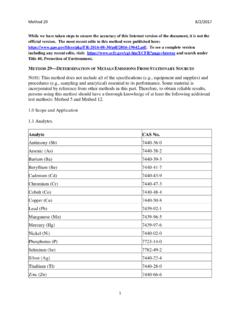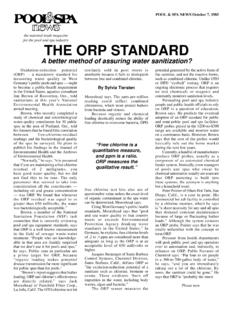Transcription of TETRAKISHYDROXYMETHYL PHOSPHONIUM …
1 TETRAKISHYDROXYMETHYLPHOSPHONIUM sulfate ( thps ):A NEW BIOCIDE WITH ENVIRONMENTALBENEFITS FOR PAPER MILLST homas K. Haack Brian DownwardAlbright & Wilson Americas, Inc Albright & Wilson UK LtdPO Box 4439210-222 Hagley Road WestGlen Allen, VA 23058-4439 West Midlands, B68 0 NNUnited KingdomBob TalbotAlbright & Wilson UK LtdPO Box 80 Oldbury, West Midlands, B69 4 LNUnited KingdomABSTRACT_____An entirely new class of antimicrobial chemistry has beenregistered with EPA for use in papermaking, based on thebiocidal molecule TetrakisHydroxymethylPhosphoniumSulfate ( thps ). The most outstanding characteristic of THPSis its ability to combine broad spectrum antimicrobial efficacywith a relatively benign human and environmental toxicityprofile. thps biocides are classified by DOT as non-hazardous, and they have very low acute toxicity in theenvironment.
2 In addition, thps degrades rapidly ondischarge to a molecule that is virtually non-toxic, therebyminimizing the risk of pollution and/or harm to biologicaleffluent treatment (BET) plants. thps biocides are fast-acting and offer excellent activity against slime formingmicroorganisms, sulfate reducing bacteria, and biofilms. Thenon-foaming thps molecule can be monitored on-site with asimple and rapid titration procedure to ensure proper trials conducted to date have shown that thps basedbiocides partition favorably to the water phase and arecompatible with paper process aids. Two successful mill trialsare described, one where the primary concern was the controlof hydrogen sulfide levels and one where it was shown thatTHPS would control process microbiological levels inwhitewater without adverse effects on the BET discovery that TetrakisHydroxymethylPhosphoniumSulfate ( thps ) could be used as a microbiocide was firstmade in 1983(1) when laboratory screening tests showed thatthe product was a potent and rapid acting bactericide.
3 Furtherlaboratory tests confirmed general microbiological activitywith particular effectiveness against sulfate reducing bacteria(SRB).The product was initially trialled in cooling water systemswhere its broad spectrum activity, coupled with its benignenvironmental profile, soon earned it a reputation as aninvaluable replacement for other biocides, especially inapplications where environmental contraints are describing some case studies in this area have beenpublished(2, 3). thps has also been used, with great success, for the control ofSRB in oilfield systems. SRB cause corrosion in oilproduction vessels and pipework and can also generate vastquantities of corrosive and toxic hydrogen sulfide (H2S)underground which contaminates produced fluids. thps hasbeen very successful in both applications, and control ofunderground H2S has provided significant operating andeconomic benefits(4).
4 Initially, the use of thps as a biocide was not possible in theUS because it was not registered with the US EPA. However,in December 1995, US EPA registration was achieved for theuse of thps as a biocide in industrial water treatment,oilfields and non-food paper applications. thps is alsoregistered for use as a preservative for solutions and emulsionsthat include various paper paper reports some experiences in Western Europe whereTHPS has been used in paper plants for the control ofmicroorganisms and is a quaternary PHOSPHONIUM salt with the followingstructure:The surprising feature about this biocidal molecule is the shortlength of the side chains. Conventionally, it was well knownthat quaternary ammonium or PHOSPHONIUM salts with at leastone long side chain were biocidally active, but those with shortside chains would normally be considered to be inactive.
5 ThisP2CH2 OHCH2 OHCH2 OHHOCH2SO4+2-means that quaternary ammonium biocides, whilst being quitebiocidally effective, suffer from the disadvantage that theyadsorb onto many types of solid surface which may causeproblems in paper manufacture. Also, some quaternarybiocides cause foam. thps does not suffer from chemistry of thps is therefore of great interest and theproduct might be expected to have significantly differentproperties to conventional quaternary expected differences were borne out in practice when itwas found, as a result of a bactericidal study, conducted by anindependent consultant, that thps was a particularly fastacting bactericide. As an illustration, figure 1 shows atime/kill profile for thps . Additional bactericidal data waspresented in a previous paper(5).Figure 1 - Effect of thps against Enterobacter AerogenesTHPSC oncentrationSurviving bacteria per ml after statedexposure time*(ppm )2 hours6 hours24 hours0 (control) x x x x x x x 100075000150000 * The initial bacterial level was x 106 thps was also found to be unusually effective against sulfatereducing bacteria (SRB), which are a particular worry due totheir tendency to produce rapid pitting corrosion.
6 It is for thisreason that thps has found extensive application in the oilindustry(3). Figure 2 shows data for the effect of thps incontrolling planktonic 2 - Effect of thps against SRBTHPSC oncentrationSurviving SRB per ml after statedexposure time*(ppm )6 Hours24 Hours0 (control) x x x x x 1000500010000* The initial SRB level was x 106In addition, thps could be easily analysed at use level, by anon-site test method, facilitating control and optimization oftreatment programs. The test method is based on a simpleiodimetric titration which takes only a few minutes to this method(6) it is possible to measure thps levelsdown to 10 ppm PROFILEB iocides, by their very nature, are designed to kill livingorganisms. It therefore came as a pleasant surprise to findthat, relative to conventional biocides, thps had an unusuallybenign environmental profile.
7 As an example, the followingdata apply to a 75% thps solution:Rainbow Trout, 96 hour LC50:119 mg/lBluegill Sunfish, 96 hour LC50:93 mg/lDaphnia Magna, 48 hour EC50:19 mg/lJuvenile Plaice, 96 hour LC50:86 mg/lSheepshead Minnow, 96 hour LC50:74 mg/lBrown Shrimp, 48 hour LC50:340 mg/lBobwhite Quail, Dietary LC50:2414 mg/lAlso, thps is classed as readily biodegradable and has nopotential to further environmental benefit is that thps is rapidlyoxidized in the environment to THPO (trishydroxy-methylphosphine oxide) which has a very low aquatic toxicityand is not considered to present an environmental has the following chemical structure:The following data illustrate the low toxicity of THPO:Rainbow Trout, 96 hour LC50: > 5000 mg/lDaphnia Magna, 48 hour EC50: > 1000 mg/lSkeletonema Costatum EC50: 2090 mg/lBoth thps and THPO will also photodegrade in on these and other data, we believe that, relative toconventional biocides, thps offers real environmentalbenefits.
8 This is further illustrated by the case historiesdetailed STUDIESCase Study No 1 - Deinking Plant, located in the UKHistoryThe plant involved in this study is a tissue manufacturing millwhich uses recycled paper as feedstock for two papermachines. The paper recycling process employs a deinkingplant which removes color from the incoming waste paper andincludes the addition of peroxide and hydrosulfite to aid theprocess and produce stock. The stock is held in large bufferstorage tanks, at 10-15% consistency. It is then diluted toapproximately 5% with recycled water before transfer to apaper ProblemThe major plant problem was hydrogen sulfide generated bySRB. This caused significant problems in working areas dueto its toxic properties. It also caused corrosion problems in thestorage tanks and paper toxicity hazard is illustrated by the fact that, in the UK,the 8 hour time weighted average occupational exposure limitfor hydrogen sulfide is 10 ppm, while that for short termexposure (up to 15 minutes) is 15 ppm(7).
9 When the stock wasuntreated, hydrogen sulfide levels in the storage tanksregularly reached levels in the region of 25 ppm. Thispresented a toxic hazard to workers and generally led to anunsafe and unpleasant working damage was a constant worry, with severe pittingattack observed in vessels and pipework and increased repairand maintenance work required as a result. Unscheduledoutages also resulted from corrosion , an isothiazolinone-based biocide had beendosed to the incoming stock in an attempt to control theproblem. This enabled partial control of the hydrogen sulfidelevels to be achieved but H2S still remained in the region of 15ppm, which was too problem was bad enough during normal plant runningconditions but, if the plant was offline for more than 6 hoursthe extra hydrogen sulfide, produced in the storage tanks understatic conditions, rose to completely unacceptable levels andcreated a severe toxic hazard in the DetailsFigure 3 shows a schematic layout for the stock storagefacility.
10 The biocide was injected into the incoming stock justbefore it enters the stock storage hydrogen sulfide levels were continuouslymonitored by a probe installed at the top of Stock StorageTower No 3 - Schematic Layout of Stock Storage FacilityCustomer RequirementsSafety requirements dictated that hydrogen sulfide levelsneeded to be adequately controlled in view of its inhalationtoxicity and the risk of excessive corrosion to the mechanicalsystem. The operators wanted the option of shutting theprocess in for periods of at least 24 hours without excessivehydrogen sulfide levels being generated in the storage ProgramThe isothiazolinone based biocide was replaced by a biocideformulation containing 75% thps (active ingredient) andproportionally dosed into the deinked stock just prior to itsentry into the Stock Storage initial dose level, based on the stock flow, was 150 ppm,as 75% active product, but this was later optimised to 80 ppmfollowing a significant reduction in hydrogen sulfide andsulfate reducing PumpExcess MachineBackwaterStock FromDe-inkingPlant 10-15%ConsistencyIntermediateStock ChestPM BlendChestPaperMachineStockStorageTowerN o 1 StockStorageTowerNo 2 StockDilutionWater75% THPSF ormulationFigure 4 illustrates the hydrogen sulfide levels the plant was running untreated, levels were in theregion of 25 ppm.





